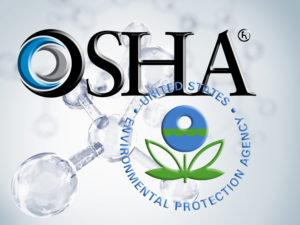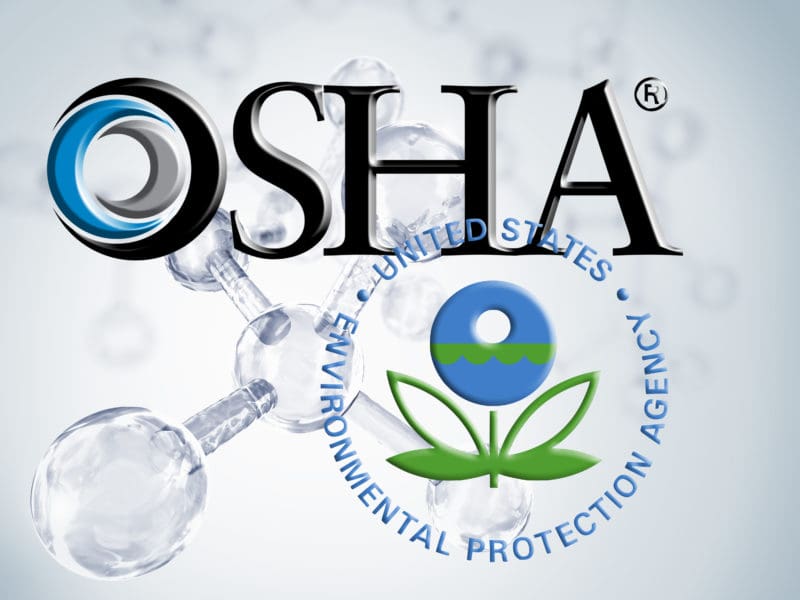
Understanding the responsibility for safety data sheets and chemical labeling is imperative to ensuring compliance with safety regulations. We’ve provided a complete guide on understanding hazardous compliance and responsibilities here. But what about the implications of hazardous materials from an environmental standpoint vs transportation requirements? Are these regulations different?
Whenever questions arise about a product’s chemistry, instinct tells us to examine its safety data sheet (SDS). An SDS, afterall, provides comprehensive information about a products properties, potential hazards, and how to properly handle the product or material safely. Without an SDS in place, suppliers, manufacturers, and distributors cannot properly disclose all of the pertinent information needed for safe handling.
However, there is an inherent problem in the reliability of some of the information found on SDSs since several sections pertaining to the environment (EPA) and transportation (DOT) are not enforced by OSHA as the information is under the jurisdiction of other agencies, which in turn will not enforce sections of a document under the jurisdiction of OSHA – a veritable catch-22.
If responsibility for environmental and transportation information doesn’t lie with those responsible for the SDS, then who is responsible for ensuring the proper handling of hazardous material when transported and proper disposal of hazardous waste?
Environmental vs. Transportation
When discussing hazardous waste and hazardous materials, it’s essential to recognize the clear responsibility that lies with the waste generator. According to the Resource Conservation and Recovery Act (RCRA), the EPA mandates that the responsibility for the proper disposal of hazardous waste falls on the entity that produces it. However, complications arise when determining when a product transitions into waste and whether that waste is classified as hazardous.
Clarifying Responsibilities in Hazardous Waste Management
Understanding the responsibilities associated with generating hazardous waste begins with a few key distinctions. One critical aspect is differentiating between consumer use and commercial activities. When you dispose of items such as personal care products or household materials at home, you act as a consumer. In contrast, if you discard the same materials during business operations, those waste materials may fall under RCRA regulations.
For instance, if you dispose of oil or paint from vehicle or home maintenance at home, you can take it to a local recycling center as a consumer. However, if you generate the same waste in a business setting, it must comply with EPA regulations. Therefore, it’s crucial never to remove hazardous waste from its origin without the involvement of a licensed and permitted reclamation service provider.
Cradle-to-Grave Responsibility
Another vital point often overlooked is that the generator’s responsibility for hazardous waste is a cradle-to-grave obligation. This phrase summarizes the generator’s duty from the moment the waste is identified as hazardous to its final disposition—whether that involves destruction, treatment, or recycling. In some cases, this responsibility may extend indefinitely, emphasizing the importance of understanding and adhering to regulations surrounding hazardous waste disposal.
By grasping these fundamental concepts of hazardous waste management, businesses and consumers can ensure compliance with environmental regulations and promote responsible disposal practices.
Defining Waste
Defining waste accurately is crucial in the realm of waste management. The late Steve Peltier, a knowledgeable sales representative in the industry, offered a valuable guideline: “If a material or product has any intrinsic value, it is not waste.”
What Constitutes Waste?
Products that might typically be labeled as waste—such as expired items or materials suitable for repurposing—shouldn’t be classified as waste if they possess intrinsic value. For instance, expired pharmaceuticals that can be returned for credit, or used oils from cooking and machinery that can be converted into fuel, illustrate this principle.
Who Determines Waste Classification?
The responsibility for determining whether a material is subject to disposal under the Resource Conservation and Recovery Act (RCRA) falls squarely on the waste generator. Once a product is deemed to have no value, it is officially classified as waste. This complicates matters when considering who qualifies as a waste generator: carpenters, dentists, doctors, mechanics, clinics, hospitals, manufacturing plants, distribution centers, and retail stores often fall into this category. Many of these entities do not commonly identify themselves as hazardous waste generators, making compliance with waste management regulations a challenging endeavor.
Testing for Hazardous Waste
To definitively determine if waste is hazardous, the waste generator should have the material tested by a certified laboratory. However, this approach can be costly and time-consuming. A more practical strategy involves understanding hazardous waste management obligations. Assume that all materials are hazardous until proven otherwise. This can be achieved by consulting the information manufacturers are required to provide in Safety Data Sheets (SDS), enforced by OSHA. Alternatively, engaging a reputable reclamation service provider can help navigate these complexities.
By grasping these fundamental concepts of waste classification and responsibilities, individuals and businesses can ensure compliance with hazardous waste regulations and promote responsible disposal practices.
Taking Responsibility
Thankfully, there are companies that specialize in working with waste generators to properly profile, manage and dispose of hazardous waste products. So when looking for a third-party reclamation service provider, do your homework – ask to see all of their federal and/or state licenses and permits – even if they require a nondisclosure agreement in the process and ask for references. Taking the time to interview prospective service providers is well worth the effort because any responsibility ultimately falls on you, the waste generator.
In our next installment, we will discuss the last of the three components of hazardous responsibility: the transportation of hazardous materials.
In navigating the complexities of hazardous waste management and compliance, having the right tools and expertise is essential. That’s where TotalSDS comes in. Our comprehensive SDS management and SDS authoring services provide businesses with a streamlined solution for maintaining compliance and ensuring safety. With our user-friendly software, you can easily access, manage, and create Safety Data Sheets, keeping your operations aligned with regulatory requirements. Trust TotalSDS to help simplify your hazardous materials management, reduce risks, and enhance workplace safety. Contact us today to learn how we can support your compliance efforts!


